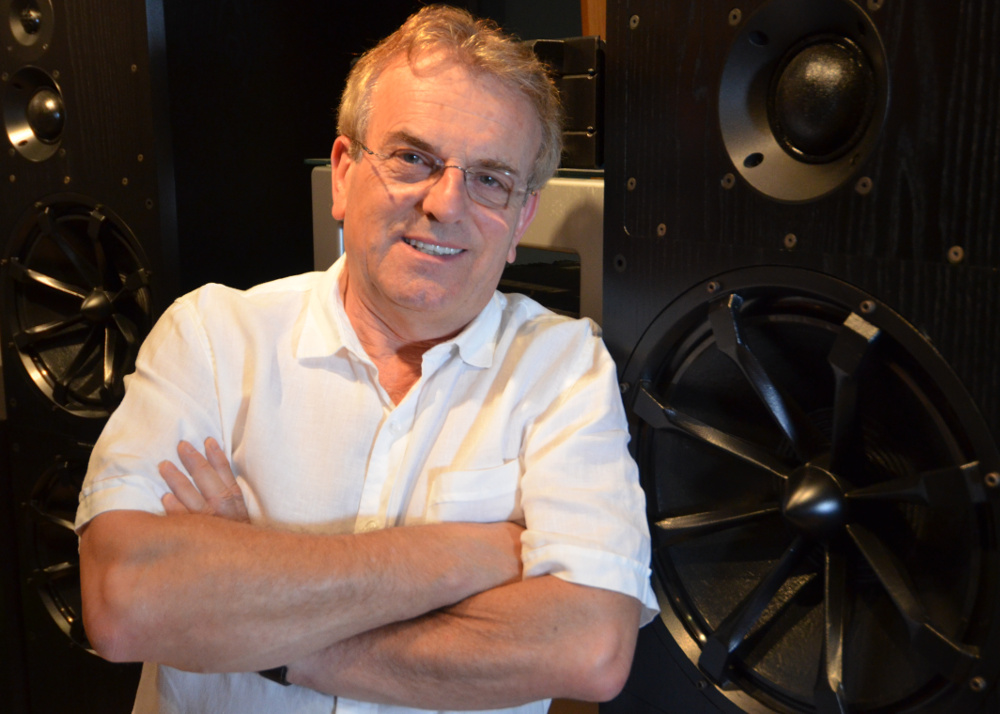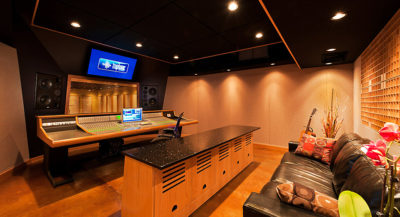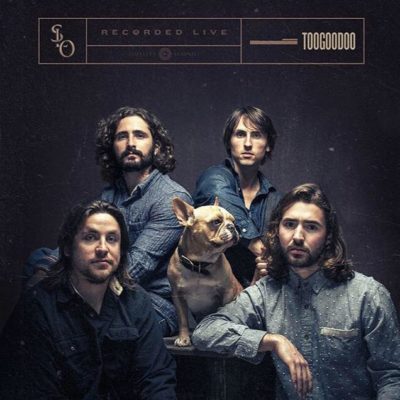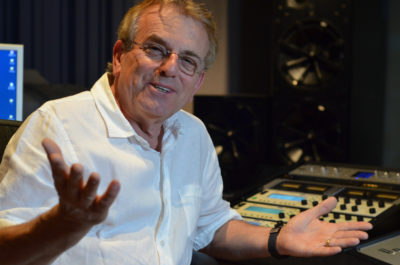Mastering Analysis: Vlado Meller – “Security” by Stop Light Observations
Take a mastering man out of the big city, and what happens? He raises his game yet again.
After decades of working his magic in Gotham a.k.a. New York City, audio icon Vlado Meller was ready for a change. When he transplanted from NYC to a most unlikely new home in Charleston, South Carolina, even Meller didn’t know how it would go.
But with his suite firmly ensconced at Truphonic Recording Studios, it’s safe to say the operation was a success. Not only did he find new inspiration in the historic city’s architecture, cuisine and culture, but he found a fresh client base waiting for him in the form of Charleston’s vibrant music scene.
Coming on 45 years in the business, Meller’s discography is massive, with credits that include the Beastie Boys, Andrea Bocelli, Johnny Cash, Charlotte Church, Celine Dion, Duran Duran, Kenny G, Kenny Loggins, Julio Iglesias, Michael Jackson, Lil Wayne, Limp Bizkit, Linkin Park, Kanye West, Kenny Loggins, Paul McCartney, Metallica, George Michael, Oasis, Pink Floyd, Public Enemy, Rage Against The Machine, Red Hot Chili Peppers, Shakira, Barbra Streisand, System Of A Down, Weezer, and Jack White. He’s kept his platinum clientele, and now he’s adding a slew of Southern bands that want his sound to finish their records.
One such artist is Stop Light Observations, a forward-looking rock four piece who’s new album Toogoodoo bowed on August 26th. Their left-of-center single “Security” is the focus of Meller’s hugely insightful Mastering Analysis here, a 5:10 anthem that plays out like a mini-movie from your speakers.
Why is an all-digital signal path the only way Meller does things in the mastering realm? How was he part of the production process long before they delivered him the two-tracks? What is his own pre-pro process that allows him to make the most out of his master?
Plus find out the highly effective old school interaction that benefited Meller and the band at Truphonic, the single most important component in the mastering chain, and his perspective on when the mastering process is truly complete. Don’t miss The Big Tip from this incredibly seasoned mastering engineer that’s here in black and white — mixers listen up! It WILL make you better.
And above all, how can you confirm for a fact that your mastering job was done right? The Vlado knows…

Vlado Meller moved his practice from NYC to Charleston, SC after decades, and landed in a very good place.
Mastering Engineer: Vlado Meller, assistant engineer: Jeremy Lubsey
Mastering facility: Vlado Meller Mastering, Charleston, South Carolina
Artist and Song: Stop Light Observations – “Security”
Album Release Date: Their album TOOGOODOO is out August 26th.
Produced by: Cubby
Engineered and mixed by: Joey Cox
Stop Light Observations is a rising rock ‘n roll group based out of Charleston, South Carolina who have been writing and playing together since middle school. Their songs consist of Southern-influenced storytelling with anthemic vocals, a wall of progressive guitars and synthesizers, and rock and hip-hop infused drums – sort of a cross between Jack White, Alt-J and Robert Plant.
From NYC to South Carolina: After working for major labels my whole life, reality hit hard when Sony decided to close their premier studio facility in New York City, followed by Universal Mastering East.
Corporate downsizing was getting to me. I needed a change. I’d had a long career in which I built up a diverse, solid client base, and since I had all of the necessary gear, the question was where I’d finally set up my own mastering studio. With New York rent prices skyrocketing, the city was not an option.
After talking to my friends in the industry – especially my current partner Paul West – I decided on Charleston, South Carolina. Paul owns a house in Charleston, so his input and knowledge about the geographic location, music scene and existing studio was very valuable.
His contacts led me to a beautiful local studio called Truphonic, and the rest is history. The studio was already built and it was a real Southern gem, with a tracking room, mixing room and now a state-of-the-art mastering room. This facility was designed by a recording studio architect, and it was already treated with diffusers and fabrics and padding and polished concrete. It was designed as a studio, not an empty space to come in and set up your equipment.
The owner and my third partner Bruce Freshley was very excited about adding the mastering room, and allocating all of the necessary space needed to create a perfect mastering studio.
Setting Up The Studio:
The biggest challenge was moving all of my gear to Charleston and setting up the room again. My former tech people at Sony, who originally built and set up my room in New York, made it as easy and seamless as possible.

The recording and mixing facilities at Truphonic, like Studio A shown here, make it a world-class Southern homestead for Meller.
As mentioned, the studio and infrastructure were there, with acoustic treatments, wiring, high-speed Internet, air conditioning, kitchen, lounge, parking – everything. Try to do that in NYC or LA, and if you can, try to make it as sustainable as this!
It was also perfect because Charleston is such a music hub in the south, and many of my new clients were going to be local bands from Charleston and surrounding areas, in addition to all of the big national clients we were already working with.
100% Digital: The majority of my clients deliver hi-res digital files for mastering. With these files I stay in the digital domain. I master in hi-res and keep my mastering chain in the client’s native resolution and bit-rate until the end. Only the CD production master will be converted to 44.1Khz/16 bit. The client already created the sound he or she likes, either through analog mixing or a combination of analog/digital processing, so my job is to stay as close as possible to the original master.
In my extensive experience with analog and digital gear, digital processing allows me to deliver to my clients the best possible sounding master, with more creative options available. I know this because the feedback coming back from my clients is overwhelmingly positive. And because the master files are kept in their original sample and bit rate, any corrections (if needed at all) are a breeze. Multiple conversions in mastering will degrade the signal.
My experience in cutting and analog mastering for vinyl is second to none. Many of my biggest records in ‘70s, ‘80s, and ‘90s were on vinyl. I started as a cutting engineer and transitioned in to digital mastering in the early ‘90s.
If the album is also coming out on vinyl, we can supply the client with a 30 IPS, 1/2 inch tape master, specifically EQ’d for vinyl. Since the vinyl is very much program and length-dependent, the EQ and levels will be different for that format.
Why They Mastered It With Me: Don’t take it from me – here’s the quote from Stop Light Observations’ versatile singer and keyboardist John-Keith Culbreth about why they choose me for their project:
“Rock ‘n roll is an attitude not a genre or sound. For example, Elvis and Jerry Lee Lewis were “rock ‘n roll” in the 50’s, just like The Beatles and Stones were in the 60’s, Led Zeppelin and Black Sabbath in the 70’s, Van Halen and Def Leopard in the 80’s, Rage Against The Machine and Oasis in the 90’s, Jack White and Kanye in the 2000’s.
They are all very different in sound and some might not even fall directly under the rock ‘n roll category, but they all have that same attitude and smack that rock has always had. They all have that common tie.
We believe Stop Light Observations is the rock ‘n roll sound of the 2010’s and 2020’s and Vlado has a way of making that attitude come to life. We chose him not because of conscience but because of his care and skill in making the mix pump with blood and oxygen and turn a body of bones into a living form. He gave us the pure rock ‘n roll attitude.”
Stop Light Observations is one of the best local bands that have come through our studio facility. I had a chance to meet all of them along with their mixing engineer, and ended up seeing them quite frequently. The town loves them, young people love them, the band puts on a great live show, and the whole country is starting to love them.
I was able to listen to their mixes as they were progressing with their project; This interaction with clients reminded me very much the golden days at CBS and Sony studios, where the whole recording process was under one roof – tracking, mixing, mastering, etc.
For a mixer to be able to hear his or her mix in the mastering room right across the hallway from the mix room is an invaluable treat. They can immediately make adjustments to their mixes after hearing what the actual final sound will be like after mastering. Not too many studios in this country have this kind of interaction today. At Truphonic studio in Charleston we can offer it and that sets us apart from a lot of other studios.
Components: The masters were digital Wav hi-res format. Recording engineer Joey Cox built a home studio in a 1700’s haunted plantation house off the Toogoodoo River where the band – described as the new era of rock ‘n roll – recorded the album live.
First Listen: I have worked with the band and Joey Cox, the mixing engineer on a few singles before. There’s great communication between the band, mixer and myself that gave me a good idea of what kind of sound the band was looking for.
Plus, I had a few listening sessions with the band in my mastering room. They loved what they heard and how I could enhance their sound, and it convinced them to master with me.
Masterful! My approach to successful mastering is to deliver the client the best possible sound, which is what they expect and want from me.
Every genre of music requires a different approach. I always confer with the artist, producer and/or mixer about their specific requests for the project, because their input is very important. It gives me an overview of what kind of sound are they going for. Some are looking for aggressive sound, some want clean, dynamic sound, some want tight low end. It all depends on genre of music I am working on. Many of my clients just want “my sound,” which they’ve heard on countless other records I mastered. We discuss everything including the loudness aspect of the album.
My digital chain includes the Weiss EQ, Weiss limiter/compressor, Sequoia workstation, and Pro Tools. I also have various plugins including complete iZotope Ozone 6 mastering software which I use selectively for additional enhancing.
Back and Forth: As I mentioned before, I am very much in touch with key people involved in the production of the album. Their feedback and my input into the whole creative process is very important to me, as the album mastering process is complete only when everybody is on the same page and has to be approved by everybody involved.
The Finality of it All: All I want to hear when a project is finished is that it sounds amazing and the client couldn’t ask for anything better. That’s incredibly rewarding to me, and it all came together at a fantastic playback party we had for Stop Light Observations at the studio in July.
Ear Education: When mixing, keep the headroom before you go to mastering. Don’t finalize, don’t use the limiters to make the sound louder.
If you deliver a proper mix to mastering, you’ll get a beautiful mastering job; if you deliver an over-the-top mix, you’ll get a bad master. Mastering cannot fix these problems; instead, it’ll enhance them, make them bigger.
One of the most important things to remember for a mastering engineer is to not try to remix the album while mastering. Try to enhance it sonically without completely changing the original mix, which the artist and producer already liked. Don’t get carried away by every plugin and piece of gear you have in your chain. I strongly believe less is more in mastering. This is what I practice and also teach in my mastering workshops.
Try to use the speaker system you trust and are familiar with. Listen to many different systems and stick with one that sounds most realistic to you, and not just the most hyped one. Speakers in the mastering room are the most important component in your chain. Without the right speakers you cannot make correct judgment on how to enhance the mix to sound better.
Practice with different EQs, compressors and limiters. Hear what each component adds to your workflow. You’ll find that some components will actually degrade the sound of the mix. Every mastering engineer has a certain sound signature, and your sound will be exclusively yours. That’s what makes every mastering engineer unique. We can use the same gear and still produce distinctly different sounds from the same master, because we all perceive the sound differently.
The ultimate judge of your work will be the artist, mixer and producer – if they like your sound, you are the winner. You are the guy to go to. Everybody else’s critique after that is BS. A happy client is the client who will come back for another album in the future. A happy mixing engineer will bring another project to you if the last one with you won him or her over with your sound.
Over the years many people have asked me what type of gear I use to create my sound, my answer was and is: The gear doesn’t matter, because it’s not the type of gear I use, it’s the sound I achieve/create with the gear I have. Be selective of how much processing you introduce to your mastering chain.
Keep in mind you’re a mastering engineer, not a remixer. You’re working with a two-track master only, how complicated can it get? I tell my students, if you want to be a rocket scientist, then work for NASA; mastering is not for you.
Learn from THE MASTER: My next mastering workshop is September 23-25 2016. We keep it to just a few applicants because I want to make sure that each person gets enough quality time mastering with me. Over the years many of my students have successfully opened their own mastering studios in Europe, South America and of course the United States.
I am very proud of them and the fact that I am training the new generation of mastering engineers, passing on my skills and experience. This three-day intensive hands-on workshop is very unique because the students are mastering in a real mastering room, real studio, real material, with every genre of music one can imagine, including their own mixes under my full supervision.If you want to participate in a workshop, you can apply on our website.
— Vlado Meller

Please note: When you buy products through links on this page, we may earn an affiliate commission.









